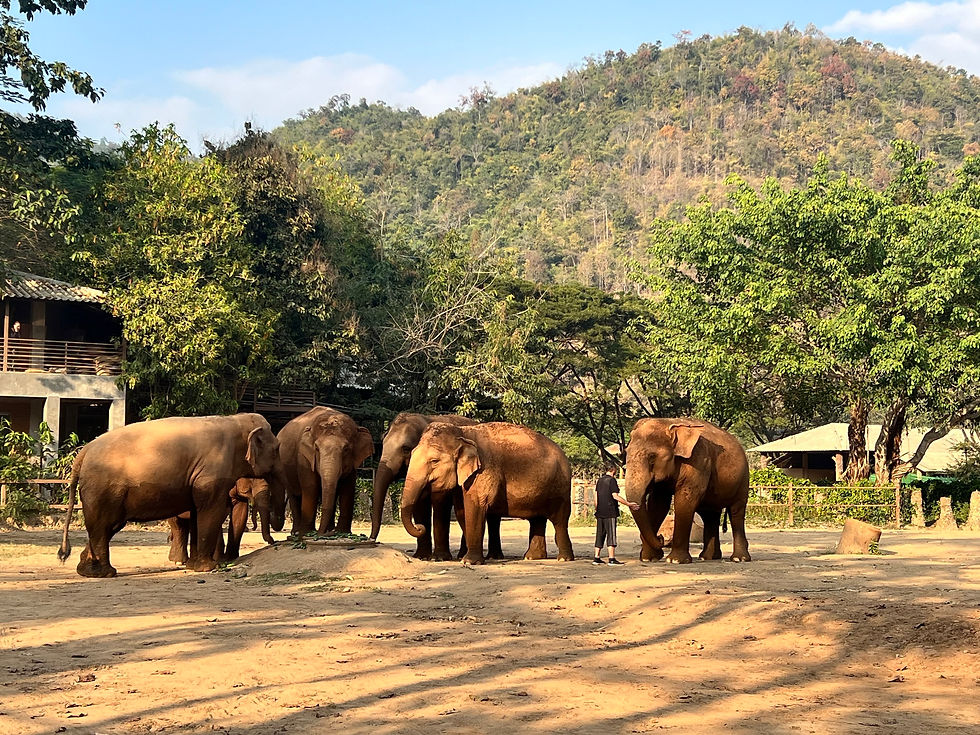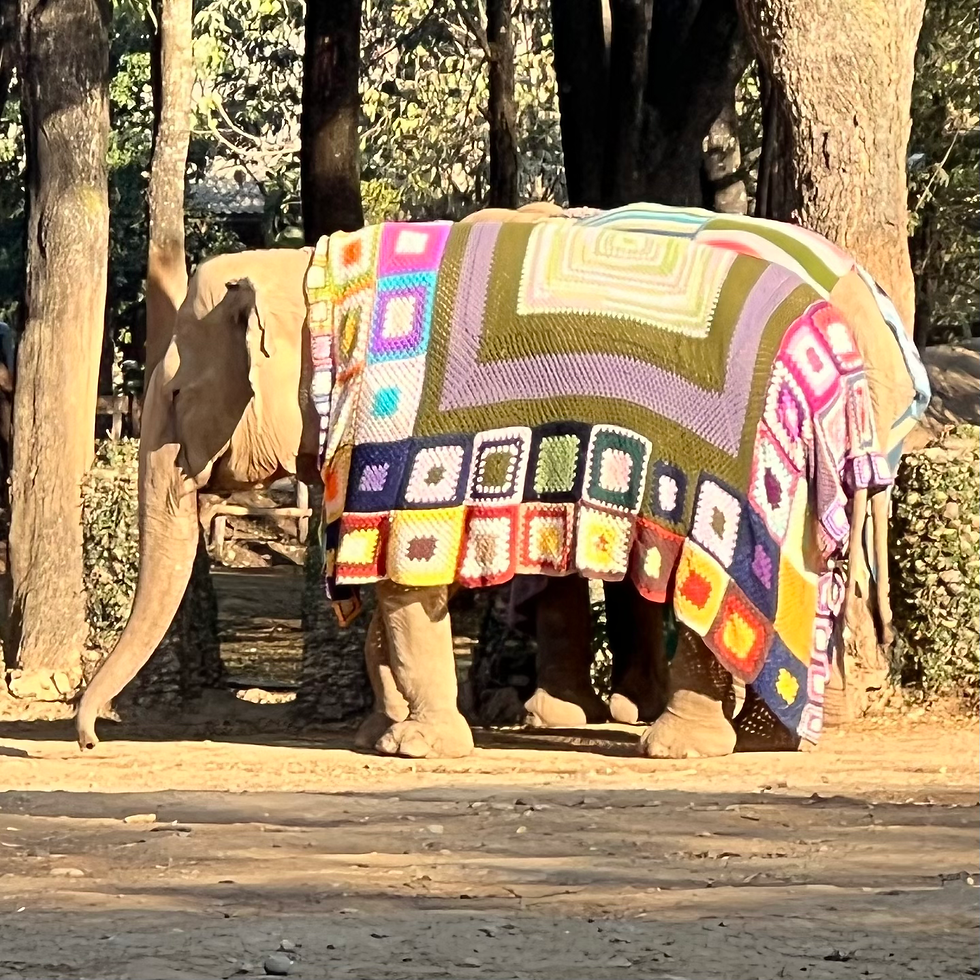Volunteering in Thailand: Here’s Why Elephant Nature Park Stands Out
- Dani Rose
- Feb 6
- 7 min read

I’ve always been fundamentally opposed to paying to volunteer. I mean, I’m volunteering; why should I pay you money? People can usually give time or they can give money, but giving both just seemed… a lot.
After volunteering for a week at the Elephant Nature Park, I can confidently say that I am anxiously looking for the next place I can pay to volunteer!
But let’s start at the beginning. When planning our family trip to Thailand, I knew we wanted to see elephants because, you know, that’s what you do in Southeast Asia. You see elephants. I quickly learned, "don’t @#$%ing ride elephants!" (and not for the reasons you think… more on that later), so I started Googling “ethical elephant sanctuaries in Thailand.” I came across an article—my memory tells me it was from National Geographic, although I can’t find it now, so maybe it was just divine intervention—that said the Elephant Nature Park was the one. Okay, great. Sold.
On their website, browsing half-day, full-day, overnight, and two-night tours, I noticed a week of volunteering. I mean, we had the time, so why not? Economically, if I wanted a two-night stay, I might as well just volunteer for the week, right? Throw in the fact that Cool was technically supposed to be in school, I figured this was an educational, once-in-a-lifetime opportunity and that a week volunteering was worth it. Click: “Reserve Now.”
Okay, where do I even begin? The entire experience was eye-opening.

The van picked us up from our hotel in Chiang Mai, and I was quickly surrounded by more Americans than I’d seen in six weeks (mostly luck of the draw). I thought I was going to work on our I-have-no-idea-how-long-this-car-ride-will-be, but the driver quickly put down a 24-inch screen and played Love and Bananas, the story of the 2015 rescue of 70-year-old Na Noi. Lemme tell you, no work was completed on that journey. Without spoiling the movie, I’ll just say I learned that any elephant who has been ridden, does tricks, paints, or logs has been separated from its mother as a baby and put through something called “The Crushing Box.” I recommend you don’t Google it. It’s awful. And this is before the sweet creature is subjected to a life of slavery.
I think this is where I have to admit that we have ridden an elephant before. Twelve years ago in Bali. It was our first trip to Southeast Asia. It was a bucket list item. We didn’t know better. I do remember thinking things felt off. I remember asking about the chained elephants, and they gave me some lame excuse that I can’t even recall now. I remember seeing the mahouts (the elephant caretakers) with hooks. I didn’t know. Now I do. Never again.

Okay, where were we? Right, the van. So we watch Love and Bananas, and right away I get a sense of the woman who started the Elephant Nature Park. Her name is Lek. She grew up in a logging town in the mountains that used elephants for hard labor, but she learned…no she chose...to do better. She’s a goddamn elephant whisperer. An angel. A rockstar. She’s who you want to be when you grow up.
And it’s not like, “I wanna be an elephant angel like Lek,” although a week here and you’ll wanna donate for the rest of your life all while trying to finagle how to come back and volunteer regularly. You just want to have as much passion for something, as much drive to do better for humanity, and to turn all that into action all while staying humble and sticking to your roots. Lek radiates passion and excellence.
The movie ended as we were pulling into the park. Coincidence? Or a REALLY well-planned 1-hour-17-minute film? The first thing you’ll notice is that there are elephants and dogs everywhere. I mean everywhere. Because in addition to having rescued 120 elephants from horrific conditions, Lek has taken in dogs because… why not? In fact, more than 5,000 animals—mostly rescued, abandoned, disabled, and old—call the Elephant Nature Park home.
The elephants are sectioned off into groups of 1–7. We’d call them herds; Lek calls them “family groups,” as traditional herds are genetically family, and these are more like dysfunctional families. All of the elephants have suffered mental issues due to their decades of abusive slavery. Much like humans, some pull out of it, and some can never quite cope. So some live a more isolated lifestyle, while others have learned to live together. Lek’s goal is to make them as happy and comfortable as possible in the years they have left. And it's a living, always malleable situation. For instance, one elephant was a loner after her best friend died of old age, and then after the flood she radiated towards a mother and her two year old son, and the mother accepted the loner as her sons nanny. Now, the ex-loner might love that baby boy elephant more than his mother! You can see her racing after him if he gets too far away or charging at dogs or anything she deems a threat to the boy. She found her new family group.

OMG, I forgot to mention—the 200-acre park was demolished by flooding three months ago. I mean destroyed. Everything Lek and her team had built… underwater. She needed to move 5,000 animals in preparation for the flood. Five thousand. Many of them can’t be around other animals. Slow. Disabled. Think of the logistics! I mean, moving one 5-ton elephant is an operational nightmare, but 120 elephants, 2,000 cats, 2,000 dogs, water buffalo, and 700 team members?

But I digress. So we roll up to orientation, and I quickly recognized the scale of this operation. They have reserves in Thailand, Cambodia, Laos, and (they had one in) Myanmar. Hundreds of tour groups daily. Volunteers. 700 employees. 5,000 animals to feed and care for. Four countries. Flood repair. Preparing for fire season. The scale is just mahoosive.

As volunteers, the week was well-planned with sweat inducing manual labor followed by elephant interactions. I mean, they need to plan for the retiree as well as the 20-something backpacker, right? We cleaned the park, worked in the kitchen, cleared a fire break for the annual fire season, and, of course, shoveled shit. The guides were personable, thorough, their English was good enough to joke with us, and they were obviously focused on safety as a priority. #DontDieThisWeek

But what really did it for me is that, as a business owner, I know a lot of people talk the talk, but VERY few walk the walk. Why? Because walking the walk is expensive; it’s so much more than the sexy end product that sells and keeps things running. Doing EVERYTHING right is hard, and so, so commendable. For instance, Derreck, Lek’s husband and business partner, will tell you that the number one thing threatening wild elephants is deforestation. And the number one cause of deforestation? Animal agriculture. Thus, how can you be all holy and righteous (my words, not theirs) about saving elephants if you eat animal products? So everything at the Elephant Nature Park is vegan. Which by the way, they should write a cookbook cuz it was hands down the best plant based food this omnivore has ever eaten.

Or like how Lek’s language about other parks is consistently positive. I’ll be the first to admit, I was all holier-than-thou—I’m going to the best park, and all the rest are lesser then. But Lek reminds us that the best way to help elephants on a massive scale is for other companies to transform. Many of them have abused their elephants for generations and simply don’t know any differently. So the first step is to get other parks to take off the chains and remove the saddles. That might mean moving to feeding and bathing interactions. While not completely ethical, at least the companies are moving in the right direction. Supporting this shift, showing them that no-chains/no-riding can be lucrative, is progress. Maybe the next year they’ll go hands-free. It’s about education, not shame, to help others understand that there is a better way. But it all starts with tourist dollars and making sure we’re supporting the “right” kind of elephant tourism.
Or like how the mahouts here at Elephant Nature Park are overwhelmingly from Burmese refugee camps, people with no hope and no home. The Burmese have trained elephants for centuries, so being a mahout is part of their culture. Lek shows them that you can be a mahout without using a hook, but rather love….and bananas. She helps create schools for their children so they don’t lose their culture and provides shelter and jobs for their families.

Or how the protocol here is to wash the animal food to make sure there is no chemical residue.
Or how Lek helped feed over 2,000 elephants—not her own—during COVID when tourism completely stopped, and many elephants were left to starve. I mean, the character and north star this woman has maintained is off the freaking charts.
And if that wasn’t enough, as I look out over the park during orientation, I can see Lek out there: mud boots, gloves, sunhat. Hands dirty. I mean, she is right in there, helping to get the work done.

So, if you’re thinking about visiting elephants in Southeast Asia, or if you’re thinking about volunteering, or if you’re thinking about donating to a cause that you know is 100% focused on its mission, I cannot recommend Elephant Nature Park enough.
Follow the good things that Lek and Elephant Nature Park are doing at: Facebook
There are ZERO dollars coming to me from this post. Clicking on the links provided will do absolutely zilch for me personally. I have not been asked to solicit you to tour or donate. It’s literally just a really fucking cool organization.























Comments